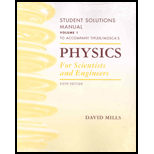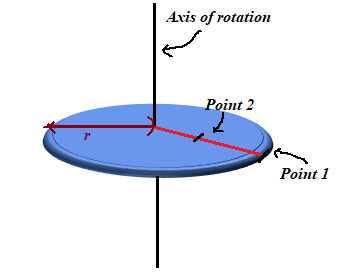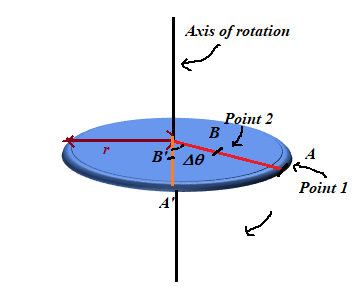
Concept explainers
(a)
The point moves a greater distance in a given time, if the disk rotates with increasing
(a)
Answer to Problem 1P
The particle on the rim covers a greater linear distance as compared to the particle situated half way between the rim and the axis of rotation.
Explanation of Solution
Given:
A disk rotating with increasing angular velocity about an axis passing through its center and perpendicular to its plane.
Distance of the particle 1 (on the rim) from the axis of rotation
Distance of particle 2 (half way between the axis of rotation and the rim) from the axis of rotation
Here, the radius of the disk is
Formula used:
The
Here,
The angular acceleration of a point on the rotating disk is related to the linear acceleration
Here,
The linear distance
Calculations:
The disk of radius
from the axis of rotation. This is shown in the figure 1 below:

Figure 1
If the disk rotates with an angular acceleration
Calculate the linear accelerations of the particles located at point 1 and 2 using the equation (2).
Substitute
Therefore, from the above equations,
If the disk is assumed to start from rest, both particles would start with their initial velocities
Use equation (3) to calculate the distance travelled by the two points.
From equation (5),
Conclusion:
Therefore, the point on the rim travels a greater distance when compared to the point located halfway between the rim and the axis of rotation.
(b)
The point that turns through a greater angle.
(b)
Answer to Problem 1P
Both the points turn through the same angle.
Explanation of Solution
Formula used:
The
Here
Calculation:
The points 1 and 2 located at points A and B on the disc rotating with an angular acceleration

Figure 2
At any instant of time, both particles have the same instantaneous angular velocity and angular acceleration. As it can be seen from Figure 2, both particles describe the same angle at an instant of time.
Conclusion:
Thus, the particle located at the rim and the particle located half way between the rim and the axis of rotation turn through the same angle.
(c)
The point which travels with greater speed.
(c)
Answer to Problem 1P
The point on the rim travels with greater speed.
Explanation of Solution
Formula used:
The instantaneous speed
Here,
Calculation:
The disk moves with increasing angular velocity. But, both points at any instant would have the same instantaneous angular velocity, since they turn through the same angle in a given interval of time.
Hence, it can be inferred from equation (7):
Since the point on the rim has the greater value of
Conclusion:
Thus, the point on the rim would have a greater speed when compared to the point located half way between the rim and the axis of rotation.
(d)
The point which has the greater angular speed.
(d)
Answer to Problem 1P
Both the particles have the same angular speed.
Explanation of Solution
Formula used:
The angular velocity of a particle is given by
Calculation:
From Figure 2, it is seen that at any instant of time, both particles 1 and 2 cover the same angles. Hence, the rate of change of their angular displacement
Conclusion:
Thus, the particle on the rim and the particle located halfway between the rim and the axis of rotation have the same angular velocity.
(e)
The point which has the greater tangential acceleration.
(e)
Answer to Problem 1P
The point on the rim has a greater tangential acceleration when compared to the point located midway between the rim and the axis of rotation:
Explanation of Solution
Formula used:
The tangential acceleration
Calculation:
If the disk rotates with a varying angular velocity, it has angular acceleration. Assuming that the angular acceleration of the disk remains constant, from equation (9) it can be inferred that
The point on the rim has the greater value of
Therefore, the point on the rim has a greater tangential acceleration when compared to any point located inside the rim. This is also proved by the fact that the point on the rim gains a larger tangential velocity when compared to any inner point.
Conclusion:
Thus, the point on the rim has a greater tangential acceleration when compared to the point located midway between the rim and the axis of rotation.
(f)
The point which has a greater angular acceleration.
(f)
Answer to Problem 1P
Both particles have the same angular acceleration.
Explanation of Solution
Formula used:
The angular acceleration
Calculation:
It has been proved in (d) that at any instant of time, both the particles have the same angular velocity. Therefore, in an interval of time
Hence, from equation (1), it can be proved that at a given instant of time, both the points will have the same angular accelerations.
Conclusion:
Thus, both particles are found to have the same angular acceleration.
(g)
The point which has the greater centripetal acceleration.
(g)
Answer to Problem 1P
The point on the rim has a greater centripetal acceleration.
Explanation of Solution
Formula used:
The centripetal acceleration of a point located at a distance
Calculation:
It has been established in part (d) that at any instant of time, the point on the rim and the point located halfway between the rim and the axis of rotation have the same angular velocity.
Therefore, from equation (10), it can be inferred that
The point on the rim has the greater value of
Conclusion:
Thus, the point on the rim has a greater centripetal acceleration.
Want to see more full solutions like this?
Chapter 9 Solutions
Physics For Scientists And Engineers Student Solutions Manual, Vol. 1
- A disk 8.00 cm in radius rotates at a constant rate of 1200 rev/min about its central axis. Determine (a) its angular speed in radians per second, (b) the tangential speed at a point 3.00 cm from its center, (c) the radial acceleration of a point on the rim, and (d) the total distance a point on the rim moves in 2.00 s.arrow_forwardA wheel 2.00 m in diameter lies in a vertical plane and rotates about its central axis with a constant angular acceleration of 4.00 rad/s2. The wheel starts at rest at t = 0, and the radius vector of a certain point P on the rim makes an angle of 57.3 with the horizontal at this time. At t = 2.00 s, find (a) the angular speed of the wheel and, for point P, (b) the tangential speed, (c) the total acceleration, and (d) the angular position.arrow_forwardA space station is coast me ted in the shape of a hollow ring of mass 5.00 104 kg. Members of the crew walk on a deck formed by the inner surface of the outer cylindrical wall of the ring, with radius r = 100 m. At rest when constructed, the ring is set rotating about its axis so that the people inside experience an effective free-fall acceleration equal to g. (Sec Fig. P11.29.) The rotation is achieved by firing two small rockets attached tangentially to opposite points on the rim of the ring, (a) What angular momentum does the space station acquirer (b) For what time interval must the rockets be fired if each exerts a thrust of 125 N?arrow_forward
- Two spheres, one hollow and one solid, are rotating with the same angular speed around an axis through their centers. Both spheres have the same mass and radius. Which sphere, if either, has the higher rotational kinetic energy? (a) The hollow I sphere, (b) The solid sphere, (c) They have the same kinetic energy.arrow_forwardA 12.0-kg solid sphere of radius 1.50 m is being rotated by applying a constant tangential force of 10.0 N at a perpendicular distance of 1.50 m from the rotation axis through the center of the sphere. If the sphere is initially at rest, how many revolutions must the sphere go through while this force is applied before it reaches an angular speed of 30.0 rad/s?arrow_forwardA wheel starts from rest and in 12.65 s is rotating with an angular speed of 5.435 rad/s. a. Find the magnitude of theconstant angular acceleration of the wheel. b. Through whatangle does the wheel move in 6.325 s?arrow_forward
- The precession angular velocity of a gyroscope is 1.0 rad/s. If the mass of the rotating disk is 0.4 kg and its radius is 30 cm, as well as the distance from the center of mass to the pivot, what is the rotation rate in rev/s of the disk?arrow_forwardWhy is the following situation impossible? Starting from rest, a disk rotates around a fixed axis through an angle of 50.0 rad in a time interval of 10.0 s. The angular acceleration of the disk is constant during the entire motion, and its final angular speed is 8.00 rad/s.arrow_forwardA turntable (disk) of radius r = 26.0 cm and rotational inertia0.400 kg m2 rotates with an angular speed of 3.00 rad/s arounda frictionless, vertical axle. A wad of clay of mass m =0.250 kg drops onto and sticks to the edge of the turntable.What is the new angular speed of the turntable?arrow_forward
- A space station is constructed in the shape of a hollow ring of mass 5.00 104 kg. Members of the crew walk on a deck formed by the inner surface of the outer cylindrical wall of the ring, with radius r = 100 m. At rest when constructed, the ring is set rotating about its axis so that the people inside experience an effective free-fall acceleration equal to g. (See Fig. P10.52.) The rotation is achieved by firing two small rockets attached tangentially to opposite points on the rim of the ring. (a) What angular momentum does the space station acquire? (b) For what time interval must the rockets be fired if each exerts a thrust of 125 N? Figure P10.52 Problems 52 and 54.arrow_forwardA playground merry-go-round of radius R = 2.00 m has a moment of inertia I = 250 kg m2 and is rotating at 10.0 rev/min about a frictionless, vertical axle. Facing the axle, a 25.0-kg child hops onto the merry-go-round and manages to sit down on the edge. What is the new angular speed of the merry-go-round?arrow_forwardConsider two objects with m1 m2 connected by a light string that passes over a pulley having a moment of inertia of I about its axis of rotation as shown in Figure P10.44. The string does not slip on the pulley or stretch. The pulley turns without friction. The two objects are released from rest separated by a vertical distance 2h. (a) Use the principle of conservation of energy to find the translational speeds of the objects as they pass each other. (b) Find the angular speed of the pulley at this time.arrow_forward
 Principles of Physics: A Calculus-Based TextPhysicsISBN:9781133104261Author:Raymond A. Serway, John W. JewettPublisher:Cengage Learning
Principles of Physics: A Calculus-Based TextPhysicsISBN:9781133104261Author:Raymond A. Serway, John W. JewettPublisher:Cengage Learning Physics for Scientists and Engineers, Technology ...PhysicsISBN:9781305116399Author:Raymond A. Serway, John W. JewettPublisher:Cengage Learning
Physics for Scientists and Engineers, Technology ...PhysicsISBN:9781305116399Author:Raymond A. Serway, John W. JewettPublisher:Cengage Learning Physics for Scientists and Engineers: Foundations...PhysicsISBN:9781133939146Author:Katz, Debora M.Publisher:Cengage Learning
Physics for Scientists and Engineers: Foundations...PhysicsISBN:9781133939146Author:Katz, Debora M.Publisher:Cengage Learning University Physics Volume 1PhysicsISBN:9781938168277Author:William Moebs, Samuel J. Ling, Jeff SannyPublisher:OpenStax - Rice University
University Physics Volume 1PhysicsISBN:9781938168277Author:William Moebs, Samuel J. Ling, Jeff SannyPublisher:OpenStax - Rice University College PhysicsPhysicsISBN:9781305952300Author:Raymond A. Serway, Chris VuillePublisher:Cengage Learning
College PhysicsPhysicsISBN:9781305952300Author:Raymond A. Serway, Chris VuillePublisher:Cengage Learning College PhysicsPhysicsISBN:9781285737027Author:Raymond A. Serway, Chris VuillePublisher:Cengage Learning
College PhysicsPhysicsISBN:9781285737027Author:Raymond A. Serway, Chris VuillePublisher:Cengage Learning





